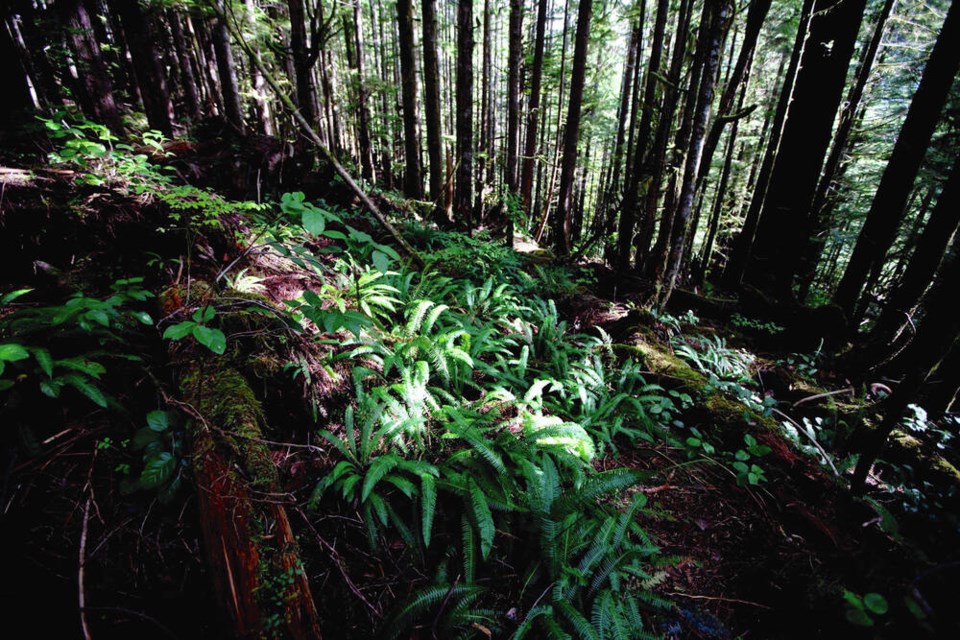In 2018, Prime Minister Justin Trudeau picked North Cowichan as the place to hold a news conference about the importance of provincial forestry jobs.
It seemed a safe and logical decision given that the municipality has a long history of logging and is home to the sa╣·╝╩┤½├Į Forest Discovery Centre.
But a lot has changed since then; local citizens are now expressing support for forest values that have little to do with chainsaws and logging trucks.
The first results of a consultation process show that residents no longer see clearcutting as the highest and best use of their 5,000-hectare Municipal Forest Reserve — a unique swath of land in sa╣·╝╩┤½├Į that is owned by North Cowichan.
Logging has not been kind to the forest reserve, which is also known as the Six Mountains — Prevost, Sicker, Richards, Maple, Tzouhalem and Stoney Hill — landmarks well known to Greater Victoria residents who recreate here.
All the old-growth forest is gone, replaced with commercial plantations. There is even an official Plantation Road sign up on Mount Prevost — the valley’s distinctive backdrop.
A report for the municipality has suggested 141 species are at risk.
And the coastal Douglas fir forest — which overlaps North Cowichan’s reserve — is the most at-risk forest in sa╣·╝╩┤½├Į That’s the conclusion of the Coastal Douglas fir Conservation Partnership, a vast coalition of governmental and non-governmental organizations chaired by a sa╣·╝╩┤½├Į forests ministry biologist, no less.
These truths have not gone unnoticed to local citizens.
The newly released Lees & Associates public consultation report — commissioned by North Cowichan — yields some astonishing findings about just how far the community has shifted from business-as-usual logging in their backyard.
Asked to identify their top considerations about the forest reserve in an online survey, citizens most strongly rated water quality, water supply protection, recreation and habitat/ecology.
Next in importance: views and visual quality, followed by climate-change benefits, air quality, mature/old forests, jobs related to tourism and recreation, and cultural/spiritual use of the forests.
Revenue to the municipality ranked 12th out of 14 choices, just above forestry jobs.
“There was agreement that the MFR is a valued community asset, and many are in favour of an approach to forest management that shifts the primary management focus of the MFR toward the ecological and recreational benefits,” the report concluded.
“The importance of protecting and enhancing the ecological benefits of the MFR was a strong theme. Many expressed concern with the health of the forest, and indicated that the ecosystem services provided by the forest outweigh the potential revenue from harvesting.”
Note also that 63 per cent of trees harvested in the forest reserve are exported as raw logs. And the last two contracted logging companies were from Nanaimo and Campbell River.
Pro-logging Mayor Al Siebring — who won by 10 votes in 2018 — recently announced he won’t seek re-election, that he wants to spend more time with family.
As recently as November, he sought the position of chair of the 15-member Cowichan Valley Regional District board, telling directors that “this is about picking the best candidate for the position, the one who is best qualified to lead this group … I am not trying to sound arrogant, but I honestly believe I’m that guy.”
He received three votes.
In North Cowichan, Siebring has been increasingly at odds with a council viewed as more environmentally progressive. He is former president of the sa╣·╝╩┤½├Į Conservative Party, whereas the community is represented federally by the NDP and provincially by the Greens.
Siebring is not only getting out of North Cowichan politics, he’s getting out of town, selling his Chemainus home and moving to Alberta.
That leaves Coun. Tek Manhas as the last man standing, the only councillor who voted to continue logging the forest reserve while the public consultation process is ongoing. He must recognize that North Cowichan is a changing community — people arriving from all across sa╣·╝╩┤½├Į, with different values.
Interestingly, Manhas — as council’s liaison to the taxpayer-subsidized sa╣·╝╩┤½├Į Forest Discovery Centre — is due to report to council soon on the centre’s response to concerns that its exhibits are biased, ignore the old-growth logging debate and don’t include historical Indigenous uses of the forests.
These are interesting times for a logging town in transition.
It’s important to note that the consultant’s findings are not a condemnation of logging in general. We need logging and the forest products it produces. In my case, working for a mill put me through journalism school in the 1970s.
The point is, this is our home, and we have overwhelmingly expressed the opinion that other values take priority.
Let’s hope that council does the right thing by its people.



